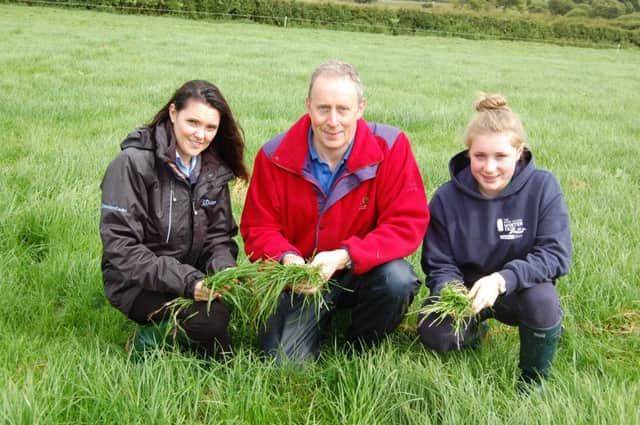Improved soil fertility boosts grassland yields


“It’s all about matching the exact requirements of the soil in the most natural way possible and, in this way, maximising grassland output and quality,” said Thomas.
“We have traditionally milked Ayrshires. The breed suits the conditions that prevail on the farm. Put simply, they can produce significant volumes of high quality milk over a long number of lactations.”
Advertisement
Hide AdAdvertisement
Hide AdHe added: “The herd is currently averaging 6,000L at 4.25% butterfat and 3.30% protein. The cows are fed an average of 2t of concentrates per lactation.
“Producing high quality replacements is a key driver for the business. The cows start calving in September, continuing though until May.”
The Grove herd has access to a 32-acre grazing block. And, as Thomas is quick to point out, making best use of this area is crucially important.
“I was always aware of how important it is to maximise soil quality,” he explained. “But it is the association built up with Grassland Agro over the past number of years that has allowed me to fully realise how fundamentally important this principle really is, when it comes to driving grassland yields.
Advertisement
Hide AdAdvertisement
Hide Ad“The company bases its commitment to all customers on the back of regular soil testing and identifying how best to release the actual nutrients that are already in the ground, so as to maximise grass growth in the most efficient way possible. This goes to the very heart of good soil management.”
Grassland Agro agronomist Chloe Kyle, a regular visitor to the Gordon farm agrees.
“Thomas and Katie are currently working on a three-year programme, designed to improve soil fertility and grassland output across the grazing block,” she said.
“Soil testing the entire block provided us with the information we needed to identify the steps that would be taken to achieve the required increase in grassland yield.
Advertisement
Hide AdAdvertisement
Hide Ad“Standard soil tests reference pH levels, Phosphate, Potash and Magnesium requirements. However, we as standard test for Calcium along with estimated Cation Exchange Capacity and quite often trace elements and Organic Matter as a matter of course.
“This approach provides a much more comprehensive picture of the soil’s overall nutrient status.”
Chloe continued: “The pH value is a key determinant of a soil’s nutrient status. As it is this factor which determines how much of a specific plant nutrient is released for crop growth purposes. Phosphate is a prime example of this. Only 10% of soils in Northern Ireland are tested regularly. But even this relatively small sample base is sufficient to confirm one very salient fact: most soils in Northern Ireland are acidic in nature.
“This matter can be easily addressed by drawing up a commensurate liming programme. And this was one of the first decisions taken when it came to settling on a suitable soil fertility development programme for Thomas and Katie.”
Advertisement
Hide AdAdvertisement
Hide AdChloe went on to confirm that the decision to include Physiolith, a calcified seaweed soil conditioner, was also taken with regard to the development of the programme.
“This acts to improve the Calcium base structure of the soil therefore leading to greater availability of important crop nutrients, including nitrogen, over a three-year cycle,” she explained.
“Analysis has shown that most soils contain from 5t to 8t/ha of mineral nitrogen, which is normally unavailable to growing crops. Physiolith, however, works to help unlock this valuable resource.
“It is usually applied at a rate of between 150kg and 200kg/acre in Year 1, dropping down to 100kg in Years 2 and 3 respectively.”
Advertisement
Hide AdAdvertisement
Hide AdThomas Gordon takes up the story. “We have carried out the initial soil testing programme, limed accordingly and spread the Physiolith at the recommended rate. Slurry is spread in late February /March at a rate of 3,000gallons/acre,” he said. “And we are already seeing a significant improvement in our grass output levels across the entire grazing block. Also it is turning out to be a win: win scenario. We are actually getting a much higher level of grassland output using significantly lower levels of chemical fertiliser.”
Chloe confirmed that all farmers using Physiolith within a balanced fertiliser plan can expect to secure the same benefits from the product.
“It will act to encourage the resurgence of perennial rye grasses within all treated swards,” she added. “Thomas and Katie are currently on an initial three-year soil fertility programme. When it is completed, we will carry out another series of soil tests to gauge the progress made up to that point and to plan for the future.”